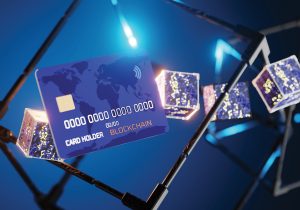 Blockchain and non-fungible tokens (NFTs) have the ability to advance the card industry, similar to gift cards when they were introduced into the market. There’s no doubt it will happen if card manufacturers adopt them and start digitalizing their businesses. Although everyone can’t afford to employ a team of software developers, it’s necessary to have knowledge of the topic and where to find the software partners.
Blockchain and non-fungible tokens (NFTs) have the ability to advance the card industry, similar to gift cards when they were introduced into the market. There’s no doubt it will happen if card manufacturers adopt them and start digitalizing their businesses. Although everyone can’t afford to employ a team of software developers, it’s necessary to have knowledge of the topic and where to find the software partners.
VariusSystems, a leader in digital identification and NFTs, pioneered a novel application of Crypto Stamp Art in Austria, with the Austrian Post in 2019. The company recently announced an expansion with the Netherlands and the United Arab Emirates. This will continue for the upcoming years. All three countries have NFT stamps in their medium- and long-term strategy plan. Many countries around Europe, Africa and Asia are now also actively exploring crypto stamps too.
Michael Dorner, chief executive officer of VariusSystems and president of the International Card Manufacturers Association (ICMA), shares insights on how blockchain, NFTs and phygitals are card industry game changers.
What is a Blockchain?
Blockchain is a system of recording information in a way that makes it difficult or impossible to change, hack or cheat the system. A blockchain is a digital ledger of transactions that’s duplicated and distributed across the entire network of computer systems on the blockchain. Once data has been recorded inside the blockchain, it becomes exceedingly difficult to change it.
A hash is a fingerprint of a block and identifies a block and all of its content. It’s always unique. Once a block is created, a hash is created. Changing something inside the block, will cause the hash to change. This is useful if you want to detect changes to blocks. If the fingerprint of a block changes, it‘s not the same block. The third element of a block is the hash of the previous block. This effectively creates a chain of blocks and makes the blockchain secure. Finally, there’s verification by each node, to make sure the block has not been tampered with.
Blockchain started in 1991. Researchers originally invented it to timestamp digital documents, so it‘s not possible to backdate them. In 2009, Satoshi Nakamoto created the first digital currency called Bitcoin, based on blockchain technology. The rise of Bitcoin was in 2011, when one bitcoin equaled $1 USD. It only took a few years to reach more than $60,000 USD. Bitcoin reached one hundred million users in 2022. Since then, there are more than one hundred million people wallets worldwide, using cryptocurrencies like Bitcoin.
Blockchain is used for the following:
- Money transactions: Sending money/funds from A to B, without having the need of a centralized institution (bank). This is called DeFi (decentralized finance).
- Product tracking: Tracking products throughout production through different manufacturers or processes. Keeping track of every step and storing it in the blockchain. This is called a Utility Token.
Digital Notary: Storing data about sellers, buyers and the contract itself in the blockchain without the need of a go-between. This is an example of a distributed ledger.
The base use case of blockchain includes:
- Cryptocurrencies: Every blockchain can have its own coin. The most popular are Bitcoin of Ethereum. The value of a coin is stored in a block and can be split (i.e., 0.345 Bitcoins).
- Tokens: A token is like a digital asset. An entry of ownership of something. It could be linked to a digital asset, or a physical asset. A token can’t be split. Both currencies and tokens can be stored in “wallets.”
A wallet is a block that contains data. In this particular case, it contains the information on which assets you own. For example, how many Bitcoins, tokens or NFTs. Everyone can have one or multiple wallets. Each wallet has a “hash address,” as it just represents another block.
What is an NFT?
An NFT is a digital asset that represents real-world objects like art, music, in-game items and videos. They’re bought and sold online, frequently with cryptocurrency, and are encoded with the same underlying software/smart contract as many cryptos.
Currently, the most popular NFTs are those within the Bored Ape Yacht Club, which has 10,000 unique images of bored apes. One of these NFTs has an average price tag of about $300,000 USD. The most expensive sold for $2.3 million USD. Owning one ape gives you full rights to use the picture and commercialize it.
Other popular NFTs are:
- Crypto Punks: The oldest NFT collection that was stored in the blockchain completely. The most expensive sale for one of these went for $10.2 million USD.
- The Kiss (Gustav Klimt): The Austrian-based museum “Belvedere” has tokenized its most precious pieces of classic art. They split up the masterpiece into 10,000 tiles and sold them for roughly $2,000 USD each. Owning one of the NFTs gives you access to special events, an annual museum pass and more.
What is a Phygital?
A phygital is a mix between a physical product and a digital asset or service. A phygital is the concept of using technology to bridge the digital world with the physical world with the purpose of providing a unique interactive service or experiences for the user.
A simple example of a phygital is the bored ape beer. It uses the rights of an NFT to create unlimited supply of physical products. It’s not considered a “real” phygital because of the missing connection/interaction.
NFTs can be used to gain access to certain services and/or goods. For example, to redeem a one out of one memorabilia, like the Classic Art Egon Schiele NFT box below. The plate is secured with an NFC chip that’s connected to the NFT in the blockchain and shows the originality/authenticity of the product.
What are the Card Industry Possibilities?
Here are the possibilities for the card industry:
- Card wallets: Cards could be used as a carrier for digital wallets. These have the actual hash of a unique wallet printed on them.
- NFT Gift Cards: Could be a game changer. They could allow minting of special NFTs of a brand or be used in gamification for more interaction with the customer.
- Access/ID Cards: A decentralized access and ID system that stores credentials on chain could allow quick and reliable checks of identities in a decentralized, secure network.
- Payment Cards: In the long-term, physical cards could be used as payment cards for digital cryptocurrencies. This requires a secure encrypted communication and allows decentralized finance worldwide.
There are numerous benefits of blockchain to the card industry because blockchain is a universal base technology that will allow interactivity and connectivity, without the need of application programming interfaces (APIs) or similar interfaces. It allows a decentralized organization of IDs and assets and a permanent availability. Blockchains can be used with completely decentralized wallets or custodial wallets, where one central department is the organizer. There are also hybrid solutions, where users can decide whether they want to “own” the wallet or not.
Gift cards can be tied to phygitals and NFTs. An example is collectible cards of NFL players. Or a game where one out of 10 gift cards hold a free burger or drink at a fast-food restaurant. You could simply sell that NFT online with ease if you don’t want to use it yourself. On the other side, it could allow an easy, anonymous purchase in an online store. “Onchain” stores are where you could pay with tokens, or even crypto, if the gift card contains cryptocurrencies. The possibilities are endless.
With the decentralized storage of data, there’s a whole new field of opportunities for the card industry. On the ID side, it could be used for quick and easy verification through Soulbound Tokens (SBTs). These are like NFTs but can’t be transferred once connected or “placed” into an individual’s wallet. This could allow for easy governance throughout multiple institutions. Gift cards could hold additional marketing media, like NFTs or gamification, for more interaction. Membership cards could even be used for online voting systems or access to certain media that only the token holder can see.
More Insights on Card Trends
For more than 30 years, ICMA has represented the interests of the card manufacturing industry—which includes manufacturers, personalizers, issuers and suppliers—as its leading global association.
ICMA offers regular educational opportunities, including virtual ACE-Commercial training, which provides sales, marketing, customer service and other key personnel at ICMA member companies with the opportunity to learn the fundamentals of card manufacturing In 2023, ACE-Commercial trainings will take place on March 8, June 14, August 23 and November 1.
Throughout the year, ICMA members have the opportunity to share insights and knowledge by giving presentations during ICMA webcasts and events. The association’s main event is its annual Card Manufacturing & Personalization EXPO. The 2023 EXPO will take place from May 15-18 in Orlando, Florida.
Learn more about the benefits of an ICMA membership.
